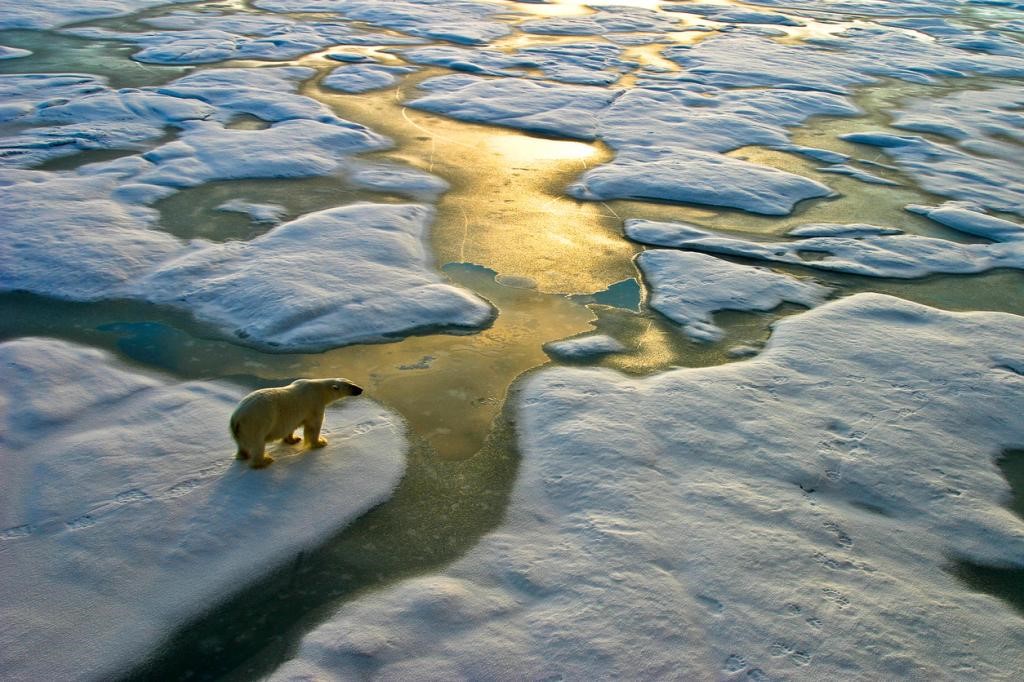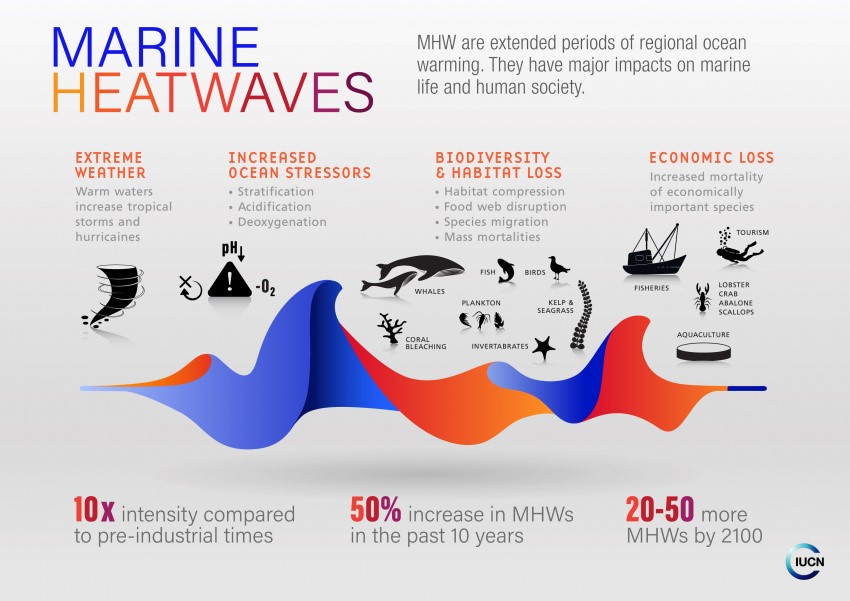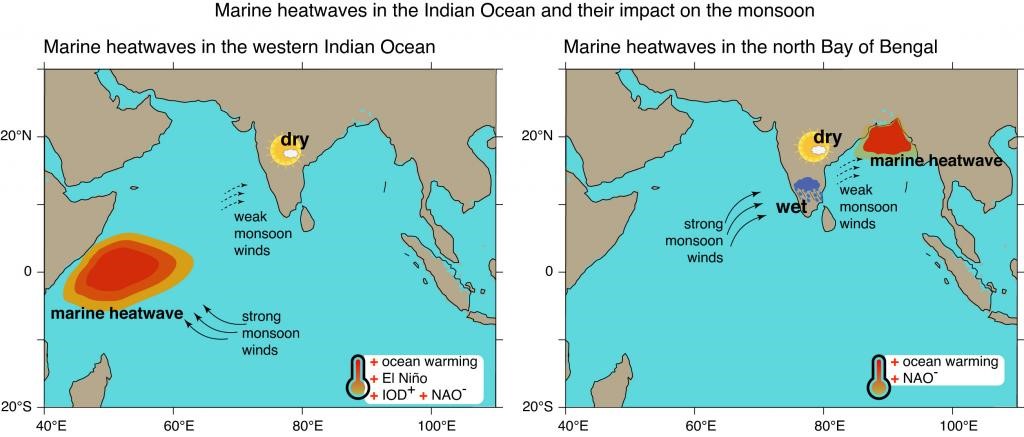Description

Disclaimer: Copyright infringement not intended.
Context
A worrying trend has emerged in the Arctic Ocean, with marine heatwaves occurring for six consecutive years from 2015 through 2021, according to a new study published in the journal.
Details
Marine heat waves (MHWs)
- A marine heat wave is an extreme weather event. A marine heatwave occurs when surface water temperatures are higher than 95 per cent (3 or 4 degree Celsius) of the values from the past 30 years for at least five consecutive days. MHWs can last for weeks, months or even years.
Impact of marine heat waves on ocean life
- Although an increase of 3 or 4 degrees Celsius in average temperatures may not be much for humans, it can be catastrophic for marine life.
Instance
- For instance, MHWs along the Western Australian coast during the summer of 2010 and 2011 caused some “devastating” fish kills — the sudden and unexpected death of many fish or other aquatic animals over a short period and mainly within a particular area — as per a 2013 study in the Journal of Marine Systems.
- A different study revealed that the same MHWs destroyed kelp forests and fundamentally altered the ecosystem of the coast. Kleps usually grow in cooler waters, providing habitat and food for many marine animals.
- Another example is when high ocean temperatures in the tropical Atlantic and Caribbean in 2005 led to a massive coral bleaching event.
- A 2010 study showed that more than 80 per cent of surveyed corals had bleached and over 40 per cent of the total surveyed had died.
- MHWs also fuel the growth of invasive alien species, which can be destructive to marine food webs. Additionally, they force species to change their behavior in a way that puts wildlife at increased risk of harm — MHWs have been linked to whale entanglements in fishing gear, according to a report by the International Union for Conservation of Nature (IUCN).
Coral bleaching
- Corals are very sensitive to the temperature of the water in which they live.
- When water gets too warm, they expel the algae known as zooxanthellae, living in their tissues, causing them to turn entirely white. This is called coral bleaching.
- When a coral bleaches, it is not dead. Corals can survive a bleaching event, but they are under more stress and are subject to mortality.
- Coral bleaching has severe consequences as it reduces the reproductivity of corals and makes them more vulnerable to fatal diseases. Not only this, thousands of marine animals depend on coral reefs for survival and damage to corals could, in turn, threaten their existence.

Marine heat waves affect humans
Stronger Hurricanes and Cyclones
- Higher ocean temperatures, which are associated with MHWs, can make storms like hurricanes and tropical cyclones stronger. With warmer temperatures, the rate of evaporation escalates and so does the transfer of heat from the oceans to the air.
- When storms travel across hot oceans, they gather more water vapour and heat. This results in more powerful winds, heavier rainfall and more flooding when storms reach the land — meaning heightened devastation for humans.
Livelihood and socio-economic impacts
- Moreover, only marine wildlife isn’t dependent on coral reefs. Half a billion people depend on reefs for food, income, and protection. So when MHWs destroy these reefs, humans relying on them also bear the brunt.
- The IUCN report pointed out that MHWs have “profound socio-economic impacts for coastal communities.” For example, in 2012, an MHW over the northwest Atlantic Ocean caused marine species that like warm water to move northwards and migrate earlier than they usually did, affecting fisheries targeting those species in the United States. All of these disastrous consequences are set to become even worse as the world continues to get warmer, making MHWs more intense and longer.
Marine heatwaves under global warming
- With the soaring global temperatures, MHWs have become longer-lasting, more frequent and intense in the past few decades.
- Between 1982 and 2016, detect a doubling in the number of MHW days, and this number is projected to further increase on average by a factor of 16 for global warming of 1.5 degrees Celsius relative to preindustrial levels and by a factor of 23 for global warming of 2.0 degrees Celsius.
- More significantly, it stated that 87 per cent of MHWs are attributable to human-induced warming.
- Research suggests that the oceans have absorbed 90 per cent of the additional heat caused by the release of greenhouse gases into the atmosphere from burning fossil fuels and deforestation in recent decades. This has increased the global mean sea surface temperature by close to 0.9 degree Celsius since 1850 and the increase over the last four decades is around 0.6 degree Celsius, according to Copernicus Climate Change Service.
- Therefore, as global air temperatures increase, so will ocean temperatures, leading to more MHWs.
- To make matters worse, El Nino — a weather pattern that refers to an abnormal warming of surface waters in the equatorial Pacific Ocean — conditions have set in for the first time in seven years.
- Scientists and experts suggest that El Nino will trigger extreme heat and increase the likelihood of breaking more temperature records in different regions of the world.

Marine heat waves in Arctic
Key Findings
- Since 2007, 11 marine heatwaves have occurred in the Arctic Ocean, with the average temperature rising 2.2 degrees Celsius above the seasonal average.
- In 2022, the Arctic saw severe and extreme marine heatwaves in the Laptev and Beaufort seas from spring to autumn.
- The Arctic has warmed by nearly four times faster than the globe since 1979.
- Further, the perennial sea ice cover over the Arctic Ocean, known to reflect solar radiation, has seen a marked decrease in both summer and winter since the mid-1990s.
- There is less and less of the thicker, several-year-old ice, while the percentage of thin, seasonal ice is consistently increasing.
- The thin ice, is less durable and melts more quickly, allowing incoming solar radiation to warm the water’s surface.
- Arctic marine heatwave events have been accompanied by a record decline in Arctic Sea ice, especially in the years 2007, 2012 and 2020.
- The marine heatwaves primarily gripped the Arctic marginal seas, including the Kara, Laptev, East Siberian, Chukchi and part of Beaufort Seas.
- These marginal seas are predominantly covered by first-year ice, floating ice of no more than a year's growth developing from young ice. Its thickness ranges from 0.3-2 metres.
- The recent prevalence of first-year ice phenomena creates extensive areas where marine heatwave events can occur and develop.
| First-year ice refers to sea ice that has formed during the current freezing season and has not survived a melting season. It typically forms in autumn and winter when seawater freezes, creating a layer of ice on the ocean surface. First-year ice is generally thinner and more vulnerable to melting compared to multi-year ice, which has survived at least one melting season. This distinction is significant for understanding the dynamics of Arctic and Antarctic sea ice, as first-year ice tends to be more responsive to changes in temperature and ocean conditions, making it an important indicator of climate change impacts on Polar Regions. |
- The first-year ice regions hinder the thorough mixing between the different layers of the sea. This prevents solar radiation from reaching the lower parts of the sea, leading to unusually high sea surface temperatures, creating conditions ripe for a marine heatwave event.
- For example, during the 2007 and 2020 events, the annual cumulative solar energy absorbed was 110 per cent and 120 per cent higher than the average rate observed during 1983-2012.
- Abrupt sea ice retreat is another concern as it could trigger marine heatwave events. The rate of sea ice melt in June-July has increased from 18×102 square kilometres per day in 1996 to 25×103 square km per day in 2021 at a speed of 38 per cent in 25 years.
- Without the involvement of greenhouse gases, marine heatwaves with intensity greater than 1.5°C could not occur. The observed 2007, 2012 and 2020 events recorded a 3.5°C, 2.1°C and 4°C intensity, respectively.
2020 marine heatwave
- The 2020 marine heatwave was the most severe in terms of intensity and duration. It lasted 103 days, with peak temperature intensity reaching 4°C over the long-term average. The probability of this occurring without human-induced warming was less than 1 per cent, the researchers highlighted.
- However, for moderate marine heatwave events, whose intensity ranges between 0.5-1°C, greenhouse gas forcing emerges as a sufficient cause (with 66-99 per cent probability). This implies that if greenhouse gas forcing continues to rise, events with moderate intensity will persistently recur.
Consequences
- Marine heatwaves in the Arctic have raised concerns over what they could mean for the fragile ecosystem. Food chains could collapse, fish stocks could be reduced and overall biodiversity could decline.

Marine heatwaves in Indian Ocean disrupt India‘s monsoon patterns

- Marine heatwaves in the tropical Indian Ocean are the least understood, though recent studies have reported their occurrence and impacts in the world’s oceans.
- In the Indian Ocean, the worst-affected were its western part and northern Bay of Bengal.
- The number of MHWs in the west Indian ocean increased by around 1.5 events per decade between 1982 and 2018. The occurrences went up by around 0.5 events per decade in north Bay of Bengal in the same period.
- There were a total of 66 events in west Indian Ocean and 94 in north Bay of Bengal in the 36 years.
- The marine heat waves in the Indian Ocean are also majorly impacting the southwest monsoon — the main rain-bearing system over the Indian subcontinent.
- The MHWs in the two worst-hit regions reduce monsoon rainfall over central India. The occurrence in north Bay of Bengal increases rainfall over the southern peninsular area.
Way Ahead
- Marine heat waves pose significant threats to marine ecosystems, biodiversity, fisheries, and coastal communities. Urgent action is needed to mitigate their impacts through robust monitoring, adaptive management strategies, and global efforts to address climate change and ocean warming.
- If current human carbon emissions are not reduced, a one-in-hundred-days event (at pre-industrial carbon dioxide levels) is projected to become a one-in-four-days event by 2031–2050 and a one-in-two-days event by 2081–2100.
|
PRACTICE QUESTION
What is “Marine Heat Wave” and how it impacts on marine ecosystem explain with examples. 200 words
|










